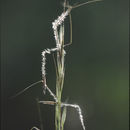Comprehensive Description
provided by North American Flora
Stipa columbiana Macoun, Cat. Can. PI. 4: 191. 1888
Slipa viridula var. minor Vasey. Contr. U. S. Nat. Herb. 3: 50. 1892. (Type from Kelso Mountain,
near Torrey Peak. Colorado.) Stipa minor Scribn. Bull. U. S. Dep. Agr. Agrost. 11: 46. 1898. (Based on 5. viridula var. minor
Vasey.)
Culms erect, glabrous, mostly 30-60 cm. tall, sometimes as much as 1 meter; sheaths glabrous, naked at the throat ; ligule rather firm, 1-2 mm. long; blades mostly involute, especially on the innovations, those of the culm sometimes flat, glabrous or nearly so, 10-20 cm. long or sometimes longer, on the innovations mostly about 0.5 mm. thick, sometimes wider on the culms; panicles narrow, compact or rather loose, often purplish, 5-15 cm. long, the branches short and appressed; glumes about 1 cm. long, nearly equal, acuminate or awn-pointed, glabrous or slightly scaberulous, 3-nerved, the nerves rather obscure because of the firm texture; lemma 6-7 mm. long, the callus short, barbed, the body densely appressed-villous, scarcely narrowed at summit, the hairs at the summit about the same as the others; awn mostly 2-2.5 cm. long, more or less twice geniculate, scabrous or somewhat scabrous-pubescent to the second bend.
Type locality: Yale. British Columbia.
Distribution: Dry plains, meadows, and open woods, South Dakota to Yukon, and southward to western Texas and California.
- bibliographic citation
- Albert Spear Hitchcock. 1935. (POALES); POACEAE (pars). North American flora. vol 17(6). New York Botanical Garden, New York, NY
Physical Description
provided by USDA PLANTS text
Perennials, Terrestrial, not aquatic, Stems nodes swollen or brittle, Stems erect or ascending, Stems caespitose, tufted, or clustered, Stems terete, round in cross section, or polygonal, Stem internodes hollow, Stems with inflorescence less than 1 m tall, Stems with inflorescence 1-2 m tall, Stems, culms, or scapes exceeding basal leaves, Leaves mostly basal, below middle of stem, Leaves mostly cauline, Leaves conspicuously 2-ranked, distichous, Leaves sheathing at base, Leaf sheath mostly open, or loose, Leaf sheath smooth, glabrous, Leaf sheat h hairy, hispid or prickly, Leaf sheath hairy at summit, throat, or collar, Leaf sheath and blade differentiated, Leaf blades linear, Leaf blades very narrow or filiform, less than 2 mm wide, Leaf blades 2-10 mm wide, Leaf blades mostly flat, Leaf blade margins folded, involute, or conduplicate, Leaf blades mostly glabrous, Leaf blades more or less hairy, Ligule present, Ligule an unfringed eciliate membrane, Inflorescence terminal, Inflorescence a contracted panicle, narrowly paniculate, branches appressed or ascending, Inflorescence solitary, with 1 spike, fascicle, glomerule, head, or cluster per stem or culm, Flowers bisexual, Spikelets pedicellate, Spikelets dorsally compressed or terete, Spikelet less than 3 mm wide, Spikelets with 1 fertile floret, Spikelets solitary at rachis nodes, Spikelets all alike and fertille, Spikelets bisexual, Spikelets disarticulating above the glumes, glumes persistent, Spikelets disarticulating beneath or between the florets, Rachilla or pedicel glabrous, Glumes present, empty bracts, Glumes 2 clearly present, Glumes equal or subequal, Glumes equal to or longer than adjacent lemma, Glumes 3 nerved, Lemma 5-7 nerved, Lemma body or surface hairy, Lemma apex acute or acuminate, Lemma distinctly awned, more than 2-3 mm, Lemma with 1 awn, Lemma awn 1-2 cm long, Lemma awn 2-4 cm long or longer, Lemma awned from tip, Lemma awn twisted, spirally coiled at base, like a corkscrew, Lemma awn twice geniculate, bent twice, Lemma margins inrolled, tightly covering palea and caryopsis, Lemma straight, Callus or base of lemma evidently hairy, Callus hairs shorter than lemma, Lemma surface pilose, setose or bristly, Palea present, well developed, Palea membranous, hyaline, Palea shorter than lemma, Stamens 3, Styles 2-fid, deeply 2-branched, Stigmas 2, Fruit - caryopsis, Caryopsis ellipsoid, longitudinally grooved, hilum long-linear.
Eriocoma occidentalis: Brief Summary
provided by wikipedia EN
Eriocoma occidentalis is a species of grass known by the common name western needlegrass. It is native to western North America from British Columbia to California to Colorado, where it grows in many types of habitat. This is a tufting perennial bunchgrass forming tight clumps of erect stems up to about 120 centimetres (47 in) in maximum height, but sometimes much shorter. The hairlike leaves are less than a millimeter wide and may have rolled edges. The inflorescence is up to 30 centimetres (12 in) long, with each hairy spikelet bearing an awn up to 4 or 5 centimeters long. The awn is kinked twice.
- license
- cc-by-sa-3.0
- copyright
- Wikipedia authors and editors

